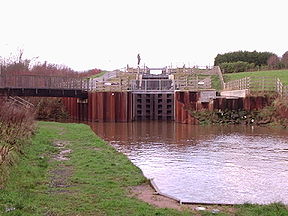Ribble Link
| The Millennium Ribble Link | |
|---|---|

The 3-rise staircase locks
|
|
| Specifications | |
| Maximum boat length | 62 ft 0 in (18.90 m) |
| Maximum boat beam | 10 ft 6 in (3.20 m) |
| Locks | 8 (1 tidal gate) |
| Status | Navigable at certain times April–October |
| Navigation authority | Canal & River Trust |
| History | |
| Original owner | The Ribble Link Construction and Operation Limited/The Waterways Trust |
| Principal engineer | Gleeson |
| Other engineer(s) | Arup Water |
| Date completed | 2002 |
| Geography | |
| Start point | Lancaster Canal, Ingol, Preston |
| End point | River Ribble |
| Ribble Link | |||||||||||||||||||||||||||||||||||||||||||||||||||||||||||||||||||||||||||||||||||||||||||||||||||||||||||||||||||||||||||||||||||||||||||||||||||||||||||||||||||||||||||||||||||
|---|---|---|---|---|---|---|---|---|---|---|---|---|---|---|---|---|---|---|---|---|---|---|---|---|---|---|---|---|---|---|---|---|---|---|---|---|---|---|---|---|---|---|---|---|---|---|---|---|---|---|---|---|---|---|---|---|---|---|---|---|---|---|---|---|---|---|---|---|---|---|---|---|---|---|---|---|---|---|---|---|---|---|---|---|---|---|---|---|---|---|---|---|---|---|---|---|---|---|---|---|---|---|---|---|---|---|---|---|---|---|---|---|---|---|---|---|---|---|---|---|---|---|---|---|---|---|---|---|---|---|---|---|---|---|---|---|---|---|---|---|---|---|---|---|---|---|---|---|---|---|---|---|---|---|---|---|---|---|---|---|---|---|---|---|---|---|---|---|---|---|---|---|---|---|---|---|---|---|---|
|
|||||||||||||||||||||||||||||||||||||||||||||||||||||||||||||||||||||||||||||||||||||||||||||||||||||||||||||||||||||||||||||||||||||||||||||||||||||||||||||||||||||||||||||||||||
The Millennium Ribble Link is a Linear Water Park and new navigation which links the once-isolated Lancaster Canal in Lancashire, England to the River Ribble. It was opened in July 2002.
"The Recipient shall ensure that the participation of the (Millennium) Commission is publicised in all public statements or announcements, and in all promotional activity concerning the Project in accordance with guidelines prescribed by the Commission".
The marshland of the River Ribble and the Savick Brook were natural obstacles preventing easy access north-west of Preston. Before the private toll road and modern roads A583/A584 were built crossing the marsh and the brook would have been much further inland, north-east of the present crossing and supportive evidence is this may have been at what is now the footbridge at Lea Golf Course. On the first 1840 Ordnance map this is called Wads Bridge but more importantly also shows a ford. This route also leads south to St Catherines Well on Lea Marsh, suggesting a route of pilgrimage and antiquity. The route north avoiding the marsh and toll road leads to the now much quieter lanes leading to the village of Clifton, which was at one time the main thoroughfare to Kirkham and the west.
Before canalisation the Savick Brook was a shallow meandering watercourse and transversing the brook was much easier in several places, formal by bridges and informal where it could simply be waded across. The Savick Brook with its fresh water and considerable fish population was an important local resource, in history and more recently into the 20th Century.
The Savick Brook, perhaps originally spelt Savock separated the local parish of Lea which after Domesday (1086) was separated as Norman or French Lea to the south while English Lea was to the north.
The Savick Brook has drained the hinterland for some considerable distance, being one of many brooks and streams that drains down from the foothills of the Pennines. Indeed, a new private toll road across the marsh was built with the toll being paid at Lea Gate, hence its name. This is now the Ribble Link bridge under the A583 Blackpool Road. No charge is now levied.
The Savick Brook by its very nature has altered course over every year and over millennia due to the structure of the land and flooded into the adjoining field systems, as a floodplain.
As part of the construction of the Ribble Link, an archeological evaluation took place to establish whether any important archeological sites would be disturbed by the new waterway.
The evaluation found signs that there could have been an old mill at Lock 8 and evidence of a ridge and furrow field system and likely to be disturbed in part by the construction. Once gain local people refer to this field as 'the Mill Field'. This is what the evaluation said about the area:
...
Wikipedia
